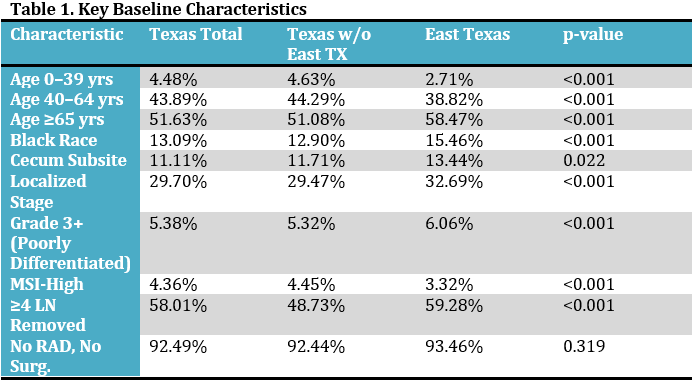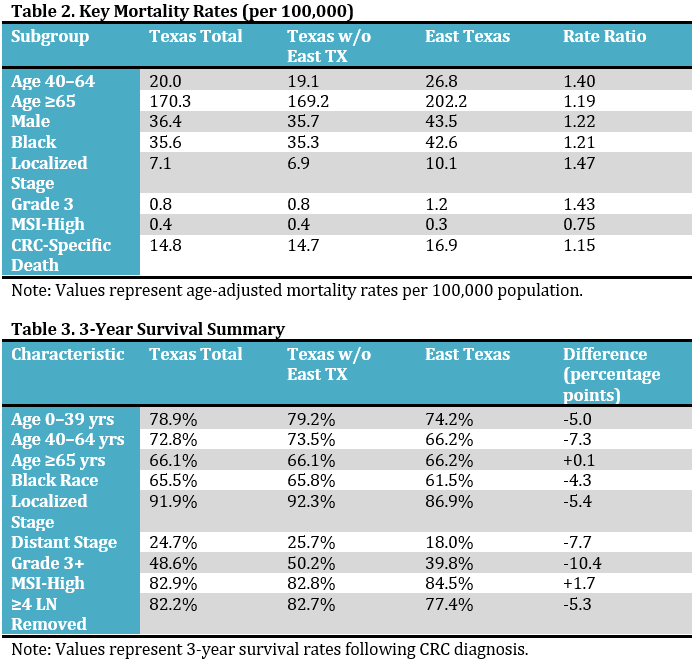Monday Poster Session
Category: Colorectal Cancer Prevention
P2618 - Disparities in Colorectal Cancer Demographics, Mortality, and Survival: A SEER-Based Comparison of East Texas and the Rest of Texas (2017–2021)
Monday, October 27, 2025
10:30 AM - 4:00 PM PDT
Location: Exhibit Hall

Layth Alzubaidy, MD
UT Health Science Center-Tyler
Tyler, TX
Presenting Author(s)
Layth Alzubaidy, MD1, Bolarinwa Olusola, MD2, Musharaf Mohiuddin, MBBS, MPH, MHS3, Christian Alvarado, PhD, MPH4, Rebecca Swindall, MS4, Alan Cook, MD, MS4
1UT Health Science Center-Tyler, Tyler, TX; 2University of Texas Health East Texas Physicians, Tyler, TX; 3UT Health Tyler, Tyler, TX; 4University of Texas Health Science Center at Tyler, Tyler, TX
Introduction: Colorectal cancer (CRC) outcomes vary by geography, race, and clinical features. East Texas, a medically underserved region, may experience disparities in presentation, treatment, and survival. Using population-based data, we aimed to describe and compare CRC characteristics, mortality, and survival between East Texas and the rest of Texas.
Methods: We conducted a descriptive analysis of CRC cases in Texas from 2017 to 2021 using the Surveillance, Epidemiology, and End Results (SEER) registry. Patients were grouped as East Texas versus Texas, excluding East Texas. We assessed demographics, tumor characteristics, microsatellite instability (MSI), lymph node assessment, mortality rates, and 3-year survival. Differences were summarized using proportions, rate ratios, and percentage point changes.
Results: Of 55,658 CRC cases, 4,398 (7.9%) were from East Texas. Compared to the rest of Texas, East Texas patients were more likely to be ≥65 years (58.5% vs. 51.1%, *p*< 0.001) and Black (15.5% vs. 12.9%, *p*< 0.001). They had higher frequencies of cecal tumors, localized disease, and lower rates of MSI-high tumors. CRC-specific mortality was higher in East Texas (16.9 vs. 14.7 per 100,000; RR 1.15), especially among patients aged 40–64 (RR 1.40) and Black individuals (RR 1.21).
Three-year survival was consistently lower in East Texas for key groups: 40–64-year-olds (66.2% vs. 73.5%, −7.3 percentage points), Black patients (61.5% vs. 65.8%, −4.3), localized stage (86.9% vs. 92.3%, −5.4), and poorly differentiated tumors (39.8% vs. 50.2%, −10.4). Notably, survival was equivalent in those ≥65 and similar in MSI-high tumors.
Discussion: East Texas CRC patients experience higher mortality and worse 3-year survival across multiple subgroups, including those aged 40–64, Black patients, and individuals with localized or high-grade tumors. These differences persist despite a similar stage distribution and lymph node assessment, suggesting non-biological contributors to outcome disparities. Our findings underscore the need for targeted, region-specific interventions to improve access to timely diagnosis, treatment, and longitudinal cancer care in East Texas.

Figure: Note: Values represent age-adjusted mortality rates per 100,000 population. RAD (radiation); MSI Microsatellite instability

Figure: Table 2: Values represent age-adjusted mortality rates per 100,000 population. Table 3: Values represent 3-year survival rates following CRC diagnosis
Disclosures:
Layth Alzubaidy indicated no relevant financial relationships.
Bolarinwa Olusola indicated no relevant financial relationships.
Musharaf Mohiuddin indicated no relevant financial relationships.
Christian Alvarado indicated no relevant financial relationships.
Rebecca Swindall indicated no relevant financial relationships.
Alan Cook indicated no relevant financial relationships.
Layth Alzubaidy, MD1, Bolarinwa Olusola, MD2, Musharaf Mohiuddin, MBBS, MPH, MHS3, Christian Alvarado, PhD, MPH4, Rebecca Swindall, MS4, Alan Cook, MD, MS4. P2618 - Disparities in Colorectal Cancer Demographics, Mortality, and Survival: A SEER-Based Comparison of East Texas and the Rest of Texas (2017–2021), ACG 2025 Annual Scientific Meeting Abstracts. Phoenix, AZ: American College of Gastroenterology.
1UT Health Science Center-Tyler, Tyler, TX; 2University of Texas Health East Texas Physicians, Tyler, TX; 3UT Health Tyler, Tyler, TX; 4University of Texas Health Science Center at Tyler, Tyler, TX
Introduction: Colorectal cancer (CRC) outcomes vary by geography, race, and clinical features. East Texas, a medically underserved region, may experience disparities in presentation, treatment, and survival. Using population-based data, we aimed to describe and compare CRC characteristics, mortality, and survival between East Texas and the rest of Texas.
Methods: We conducted a descriptive analysis of CRC cases in Texas from 2017 to 2021 using the Surveillance, Epidemiology, and End Results (SEER) registry. Patients were grouped as East Texas versus Texas, excluding East Texas. We assessed demographics, tumor characteristics, microsatellite instability (MSI), lymph node assessment, mortality rates, and 3-year survival. Differences were summarized using proportions, rate ratios, and percentage point changes.
Results: Of 55,658 CRC cases, 4,398 (7.9%) were from East Texas. Compared to the rest of Texas, East Texas patients were more likely to be ≥65 years (58.5% vs. 51.1%, *p*< 0.001) and Black (15.5% vs. 12.9%, *p*< 0.001). They had higher frequencies of cecal tumors, localized disease, and lower rates of MSI-high tumors. CRC-specific mortality was higher in East Texas (16.9 vs. 14.7 per 100,000; RR 1.15), especially among patients aged 40–64 (RR 1.40) and Black individuals (RR 1.21).
Three-year survival was consistently lower in East Texas for key groups: 40–64-year-olds (66.2% vs. 73.5%, −7.3 percentage points), Black patients (61.5% vs. 65.8%, −4.3), localized stage (86.9% vs. 92.3%, −5.4), and poorly differentiated tumors (39.8% vs. 50.2%, −10.4). Notably, survival was equivalent in those ≥65 and similar in MSI-high tumors.
Discussion: East Texas CRC patients experience higher mortality and worse 3-year survival across multiple subgroups, including those aged 40–64, Black patients, and individuals with localized or high-grade tumors. These differences persist despite a similar stage distribution and lymph node assessment, suggesting non-biological contributors to outcome disparities. Our findings underscore the need for targeted, region-specific interventions to improve access to timely diagnosis, treatment, and longitudinal cancer care in East Texas.

Figure: Note: Values represent age-adjusted mortality rates per 100,000 population. RAD (radiation); MSI Microsatellite instability

Figure: Table 2: Values represent age-adjusted mortality rates per 100,000 population. Table 3: Values represent 3-year survival rates following CRC diagnosis
Disclosures:
Layth Alzubaidy indicated no relevant financial relationships.
Bolarinwa Olusola indicated no relevant financial relationships.
Musharaf Mohiuddin indicated no relevant financial relationships.
Christian Alvarado indicated no relevant financial relationships.
Rebecca Swindall indicated no relevant financial relationships.
Alan Cook indicated no relevant financial relationships.
Layth Alzubaidy, MD1, Bolarinwa Olusola, MD2, Musharaf Mohiuddin, MBBS, MPH, MHS3, Christian Alvarado, PhD, MPH4, Rebecca Swindall, MS4, Alan Cook, MD, MS4. P2618 - Disparities in Colorectal Cancer Demographics, Mortality, and Survival: A SEER-Based Comparison of East Texas and the Rest of Texas (2017–2021), ACG 2025 Annual Scientific Meeting Abstracts. Phoenix, AZ: American College of Gastroenterology.
